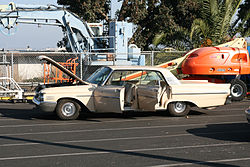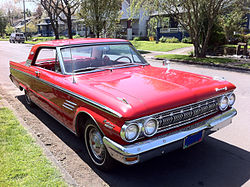- Mercury Meteor
-
For the model by the same name offered in Canada from 1949 to 1976, see Ford Meteor (Canada).
Mercury Meteor 
Manufacturer Ford Motor Company Production 1961–1963 Class Full-Size (1961)
Mid-size (1962–1963)Body style 2-door hardtop
2-door sedan
4-door sedan
4-door hardtop
4-door station wagonLayout FR layout The Mercury Meteor was an automobile model produced by the Lincoln Mercury division of the Ford Motor Company from 1961 to 1963. For 1961, the name was applied to low-end full-sized vehicles; for 1962 and 1963, the name was applied to Mercury's mid-sized sedans, in a marketing attempt to appeal to the excitement surrounding the Space Race, before being discontinued. Introduced while Mercury as a marque was in flux, and never a solid marketplace performer in consumer sales, the Meteor remains more an "asterisk" than as a well known Mercury product.
Contents
Canadian Meteor
Initially, Ford used the Meteor nameplate in 1949 when it created a stand alone brand of vehicles that used Ford bodies trimmed using Mercury parts for sale specifically in the Canadian marketplace. Meteors were produced and sold in Canada until 1961, and then reintroduced again from 1964-76, after the US model using the name was discontinued.
Factors affecting the creation of the Mercury Meteor
In the mid 1950s, Ford Executives were convinced by Ernest Breech that in order to compete with General Motors, the automaker had to meet each sales segment with unique product. The plan impacted Mercury by calling for the marques completely new platform and body design since World War II in order to differentiate it from the Ford beginning with the 1957 model year.
Historically, Mercury was usually considered a "lower-medium-priced" car, most often compared to Pontiac and Dodge. Under Breech's plan Mercury would move upmarket and compete more directly with Buick, Oldsmobile, Chrysler and DeSoto and the Edsel would take over Mercury's previous role as the "lower-medium-priced" car and compete more directly with Pontiac and Dodge.
While Breech’s plan could have succeeded in the early 1950s, by the late 1950s the bottom was beginning to drop out of the middle price car market; the 1958 recession effectively rendered Breech’s plan obsolete. Sales of Ford’s Edsel marque were a complete disaster.
Sales of Mercury products failed to reach expected sale levels, leading to cost cutting decisions beginning in the 1961 model year. Had Robert S. McNamara, then head of the Ford division, had his way, Lincoln, Edsel and Mercury would have been relegated to the dustbin of history. Instead, a compromise decision was made, and beginning in 1961 Ford and Mercury would use the basic Ford body shells, and rely upon unique trim elements to differentiate the marques one from another. Edsel, meanwhile, was discontinued after a short run of 1960 models; what emerged as the 1961 Mercury was really initially intended as the 1961 Edsel.
1961 Mercury Meteor
First Generation 
Production 1960–1961 Assembly Los Angeles, California
Mahwah, New Jersey
St. Louis, Missouri
Wayne, MichiganBody style 2-door sedan
2-door hardtop
4-door hardtop
4-door sedanEngine 223 in³ OHV Straight-6
292 in³ Y-block V8
352 in³ FE V8
390 in³ FE V8Transmission 2-speed automatic
3-speed automatic
2-speed manualWheelbase 3,047 mm (120.0 in) Related Ford Fairlane
Ford Galaxie
Mercury MontereyThe first step taken to make Mercury cost effective within Ford, Mercury shed its higher priced Montclair and Park Lane models. The Monterey, previously the entry-level full-sized Mercury offering and priced slightly higher for the 1961 model year than comparable 1960 models, would become the new top-of-the-line model. It was joined by the new, lower-priced Meteor 600 and Meteor 800. The Meteor 600 and Meteor 800 were, respectively, the spiritual descendants of the Medalist and Custom models last offered in 1956, as well as replacements for the discontinued Edsel. All full-sized 1961 Mercurys rode on a 120” wheelbase.
For 1961 the Meteor was a full-sized model, differentiated from the Monterey through its trim and taillights. Meteor 600 taillights were oblong while the Meteor 800 and upmarket Monterey used six circular tail lights, three on each side. Meteor 600s, available only as two and four-door sedans featured chrome spears from the taillights to the front wheels. Meteor 800s, available in two and four door sedan and hardtop body styles, featured the spear and three chrome bars on the front fenders, chrome fender fin trim, rocker panel trim and back-up lights.
The Commuter 4-door station wagon was trimmed comparably to the Meteors, while the Colony Park with simulated woodgrain trim on the side-panels was trimmed comparably to the Monterey.
The standard engine in the Meteor and Commuter was a 223 cubic inch displacement inline six-cylinder with a 1-barrel carburetor that generated 135 horsepower (101 kW) @ 4000 rpm. Optional engines included a 292 cubic inch displacement V-8 with 2-barrel carburetor generating 175 horsepower (130 kW) @ 4200 rpm (standard on the Monterey on Colony Park), as well as a 352 cubic inch Marauder V-8 with 2-barrel carburetor generating 220 horsepower (160 kW), a 390 cubic inch Marauder V-8 with 4-barrel carburetor generating 300 horsepower (220 kW), and a 390 cubic inch Marauder V-8 with 4-barrel carburetor generating 330 horsepower (250 kW).
The standard transmission was a 3-speed manual with overdrive available as an option. Merc-O-Matic and Multi-Drive automatic transmissions were available as options.
1962–1963 Mercury Meteor
Second Generation 
Production 1962–1963 Assembly Dearborn, Michigan
Kansas City, MissouriBody style 2-door sedan
2-door hardtop
4-door sedan
4-door Station WagonEngine 170 in³ OHV Straight-6
221 in³ Windsor V8
260 in³ Windsor V8Transmission 2-speed automatic
3-speed automatic
3-speed manual
4-speed manualWheelbase 2,934 mm (115.5 in) Related Ford Fairlane For 1962, Mercury marketing decided that the Monterey nameplate had better consumer recognition than the Meteor moniker as far as full-sized vehicles were concerned (despite the fact that Meteor outsold Monterey), and instead assigned the Meteor name to a new line of mid-sized cars based on the Ford Fairlane which, in turn, was based on a long-wheelbase version of the Ford Falcon chassis. This smaller, mid-sized Meteor filled the product gap between the full-sized Monterey and the compact, Ford Falcon-based Mercury Comet.
Riding the Fairlane’s 116.5 wheelbase, the 1962 Meteors wore unique rear quarter panels that mimicked the Monterey's jet-pod tail lights. The base Meteor and better trimmed Meteor Custom were available in two and four door sedans. The Meteor S-33 was a specially trimmed two door sedan featuring premium exterior trim and interior appointments including bucket seats, and a center console.
For 1963 Meteors received an annual trim update and the addition of two body styles, a four-door station wagon and a two-door hardtop coupe. The four-door station wagon was added to both the Meteor series and the Meteor Custom series. In the Meteor Custom series the station wagon was referred to as the Mercury Country Cruiser and featured simulated wood-grain trim on the exterior. The hardtop coupe was added to the Meteor Custom and Meteor S-33 series. The hardtop coupe replaced the 2-door sedan in the Meteor S-33 series.
The base Meteor engine was a 170 cubic inch displacement inline 6-cylinder engine with a 1-barrel carburetor 101 horsepower (75 kW) @ 4000 rpm. Optional engines included a 221 cubic inch V-8 with 2-barrel carburetor that generated 145 horsepower (108 kW) and a 260 cubic inch V-8 with 2-barrel carburetor that generated 164 horsepower (122 kW). A three-speed manual transmission was standard. Overdrive and Merc-O-Matic automatic transmissions were options. A 4-speed manual transmission became an option for 1963.
Sales of the mid-sized Mercury Meteor were disappointing and the model was discontinued at the end of the 1963 model year.
A name without a purpose
Mercury product planning underwent another shift with the departure of fiscal conservative Robert McNamara from Ford. What had been McNamara’s attempts to remake Mercury as a senior Ford were discarded, and instead for 1965 Mercury would be marketed as being "built in the Lincoln tradition."
The first step towards this goal was the elimination of the compact-bodied Comet. Although Mercury had no mid-sized car for the 1964 and 1965 model years, the compact Comet continued to sell well during this time. Because the Comet name had better recognition than Meteor, the Comet name was transferred to Mercury's mid-sized car based on the Ford Fairlane beginning with the 1966 model year, in effect finally replacing the Meteor model and name that had last been built and used in 1963. For 1964, the Meteor name returned on a series of full-size models in the Canadian market, much as had been the case until 1961.
References
- Gunnell, John, Editor (1987). The Standard Catalog of American Cars 1946-1975. Kraus Publications. ISBN 0-87341-096-3.
External links
 Media related to Mercury Meteor at Wikimedia Commons
Media related to Mercury Meteor at Wikimedia CommonsMercury, a division of Ford Motor Company, 1939–2011 Category · Vehicles Final models
(2010-2011)Historic models Bobcat · Brougham · Capri · Colony Park · Comet · Commuter · Custom · Cougar · Cyclone · Eight · LN7 · Lynx · M-Series · Marauder · Marquis · Medalist · Meteor · Monarch · Montclair · Montego · Monterey (car) · Monterey (mini-van) · Mystique · Park Lane Brougham · S-55 · Sable · Topaz · Tracer · Turnpike Cruiser · Villager · Voyager · ZephyrConcept cars Mercury passenger vehicle timeline, 1950–1989 — next » Type 1950s 1960s 1970s 1980s 0 1 2 3 4 5 6 7 8 9 0 1 2 3 4 5 6 7 8 9 0 1 2 3 4 5 6 7 8 9 0 1 2 3 4 5 6 7 8 9 Subcompact Bobcat Lynx Tracer Compact Comet Comet Comet Zephyr Topaz Topaz Monarch Mid-size Meteor Montego Cougar Cougar Marquis Comet Comet Sable Full-size Eight Montclair Meteor Montclair Monterey Monterey Monterey Monterey Monterey Monterey Park Lane Park Lane Marquis Marquis Marquis Grand Marquis Brougham Turnpike Cruiser S-55 S-55 Marauder Marauder C. Park Colony Park Colony Park Colony Park Colony Park Colony Park Commuter Commuter Commuter Voyager Sports car Capri Capri Cougar Cougar LN7 Personal Cougar Cougar Cougar Cougar Cougar Categories:- Mercury vehicles
Wikimedia Foundation. 2010.
